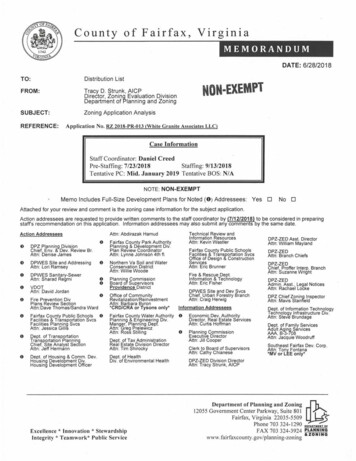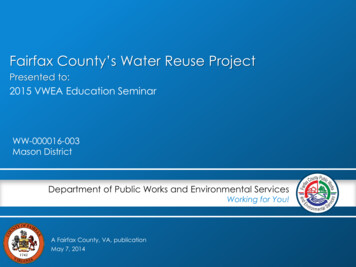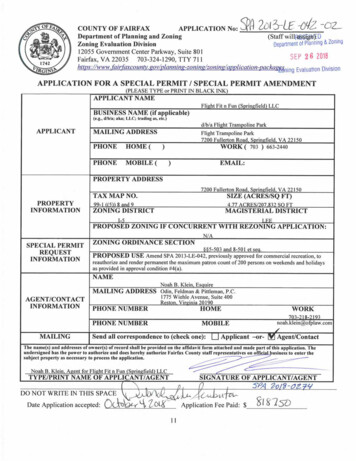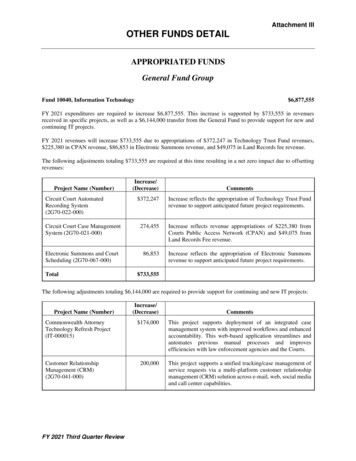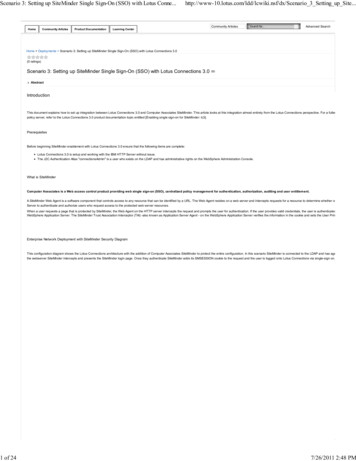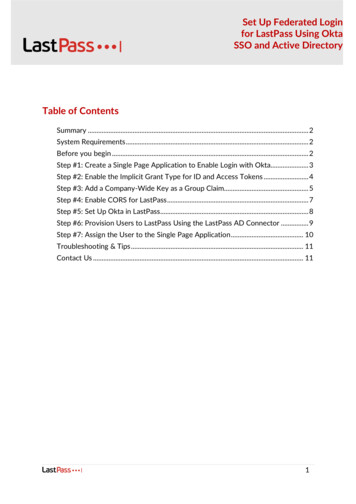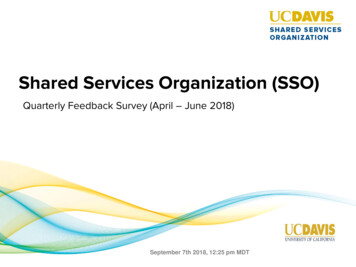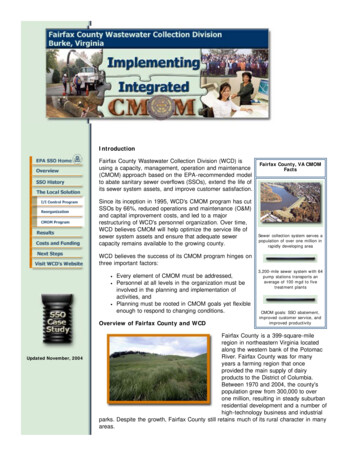
Transcription
IntroductionFairfax County Wastewater Collection Division (WCD) isusing a capacity, management, operation and maintenance(CMOM) approach based on the EPA-recommended modelto abate sanitary sewer overflows (SSOs), extend the life ofits sewer system assets, and improve customer satisfaction.Since its inception in 1995, WCD's CMOM program has cutSSOs by 66%, reduced operations and maintenance (O&M)and capital improvement costs, and led to a majorrestructuring of WCD's personnel organization. Over time,WCD believes CMOM will help optimize the service life ofsewer system assets and ensure that adequate sewercapacity remains available to the growing county.Fairfax County, VA CMOMFactsSewer collection system serves apopulation of over one million inrapidly developing areaWCD believes the success of its CMOM program hinges onthree important factors:Every element of CMOM must be addressed,Personnel at all levels in the organization must beinvolved in the planning and implementation ofactivities, andPlanning must be rooted in CMOM goals yet flexibleenough to respond to changing conditions.Overview of Fairfax County and WCDUpdated November, 20043,200-mile sewer system with 64pump stations transports anaverage of 100 mgd to fivetreatment plantsCMOM goals: SSO abatement,improved customer service, andimproved productivityFairfax County is a 399-square-mileregion in northeastern Virginia locatedalong the western bank of the PotomacRiver. Fairfax County was for manyyears a farming region that onceprovided the main supply of dairyproducts to the District of Columbia.Between 1970 and 2004, the county'spopulation grew from 300,000 to overone million, resulting in steady suburbanresidential development and a number ofhigh-technology business and industrialparks. Despite the growth, Fairfax County still retains much of its rural character in manyareas.
The WCD sewer collection system serves 234 square miles ofFairfax County and nearly 85% of its population. Some partsof the county are not sewered, including some portions of theOccoquan Reservoir watershed in the extreme westernportion of the county, and the Great Falls area in the north.The Occoquan Reservoir is protected from developmentbecause it is a major source of drinking water, and the GreatFalls area contains a number of state park lands.WCD Service AreaClick to view a map ofThe 3,200-mile sanitary sewer system contains 64 pumpWCD'ssewer collectionstations, 280 grinder pumps, 53 permanent flow meters, andservicearea.11 rain gauges. The oldest system components were installedin areas that developed around the City of Alexandria andArlington County in the 1940s and 1950s. Components wereadded as the system grew south and west over the next 60years. Older lines were constructed using vitrified clay pipe. Lines installed between1950 and 1970 were primarily concrete, and lines installed after 1970 were made ofPVC. The system collects an average of 100 million gallons per day (mgd) of flow anddelivers it to five treatment plants: Fairfax County's Noman M. Cole, Jr., Pollution ControlPlant (which receives 45% of the flow), and four regional treatment facilities operated bythe Alexandria Sewerage Authority (ASA), District of Columbia Water and SewerAuthority, the Upper Occoquan Sewage Authority, and Arlington County.SSO HistoryWCD began tracking SSOs closely in 1995, when there were 128 occurrences. Therewere no known water quality violations as a result of SSOs, and 22 sewer damageclaims were paid to private property owners. WCD's primary reason for embarking onmajor operational and management changes were based on its desire to improvecustomer service and to prepare for the anticipated EPA SSO control rule, which at thattime was in the early stages of development.The Local Solution: Integrated CMOMTargeted I/I Reduction Program Exposes Underlying ProblemsIn 1995, engineering design for upgrading and improving the ASA wastewater treatmentplant was underway, and peak flows from the two contributing jurisdictions (FairfaxCounty and the City of Alexandria) were an issue. WCD's wet weather peak flows ofmore than 80 mgd were well over its allocation of 65 mgd. Rather than construct a largewastewater storage facility to contain excess peak volumes, WCD opted to reduce I/Iinto its system in the service area contributing flow to ASA. WCD had already planned asimilar I/I abatement program in the adjacent Little Hunting Creek (LHC) sewershed inthe historic Mount Vernon area, so a sewer system evaluation study (SSES) of bothareas was launched. In addition, WCD began tracking SSOs throughout the collectionsystem.The SSES included CCTV inspection of all trunk sewers in the LHC area. The videorevealed that several large diameter (15-inch and above) lines were severelydeteriorated due to age and corrosion. Prior physical inspection of these lines had failedto detect the severity of deterioration. These trunk sewers were rehabilitated during 1995and 1996 using the cured-in-place pipe relining process to restore structural integrity;however, little I/I improvement was observed.In 1996, the inspection program was expanded to include sewer mains in the ASA area.Using flow data from the hydraulic study, WCD ranked the three ASA subsewershedsaccording to the severity of I/I, and discovered the most serious problems wereconcentrated in the Dowden Terrace sewershed. Comprehensive television inspectionwas performed on all sewer mains in this area, revealing a large number of deterioratedlines. These lines were rehabilitated using trenchless rehabilitation processes, including
cured-in-place, fold-and-form, pipe bursting, and a robotic point repair system. Theserepairs yielded significant progress toward WCD's goal of reducing peak flows to theASA plant, with peak flows reduced to below 50 mgd—well below the target reduction of65 mgd.The rehabilitation project also led to a slight reduction in SSOs, but the continuingincidence of basement backups and manhole surcharges indicated that more work wasneeded. As a result of the SSO data tracking and the extensive video inspections, WCDlearned that except for a few overflows caused by vandalism, most SSOs resulted fromgrease buildup and root intrusion. Because the rehabilitation efforts had been focused inthe ASA area, the number of blockages had remained high in other parts of the system.WCD realized that in order to address the blockages effectively, the program had to beexpanded to the entire system, and had to address operation and maintenance (O&M)issues as well as rehabilitation needs.WCD's CMOM program mirrors the approach identified by EPA in the draft SSO ControlRule. WCD believes that CMOM works best as a system, and leaving out one elementdiminishes the value of the effort; therefore, no elements were overlooked.WCD Restructures to Accommodate New CMOM ApproachClick on the links below toWith the other branches of the Fairfax County Wastewaterlearn more about WCD'sManagement Program, WCD underwent leadership trainingstrategic planningon the High Performance Organization (HPO) model throughstatements.the University of Virginia's Senior Executive Institute. TheHPO model provides a framework to create a participativeVisionand collaborative work culture through team-building,improving communication, and empowering front lineMissionemployees. The first step was to establish vision, mission,values and leadership philosophy, which constitute theLeadership Philosophyguiding principles of the Wastewater Management Program.These principles were used in the development of aValuesstrategic plan for the entire CMOM program.Within WCD, the primary strategic plan activity is improving the relationship betweenmanagement and field staff. Formerly a typical hierarchical or top-down organization,WCD now involves field staff in program planning and encourages them to use theirknowledge and expertise to make decisions and improve collection system operationand customer service. In fact, staff involvement was critical to the development of theCMOM program. By collaborating closely with field staff, WCD gained the benefit of theiryears of expertise and ensured their enthusiastic cooperation in implementing the newprocedures.CMOM Program ElementsTo learn more about the elements of WCD's CMOM program, click on the links below.Goals, Organization and LegalAuthorityMeasures and ActivitiesDesign and PerformanceProvisionsMonitoring, Measuring andModificationOverflow Response PlanningProgram Audit
ResultsThe success of WCD's CMOM program is measured by reductions in the number andimpacts of SSOs, and by reductions to peak flows to the ASA wastewater treatmentplant.SSO ReductionsBetween 1995 and 2004, WCD reduced the number ofSSOs by 66%, and also made significant reductions in theimpact of SSOs on the environment and private property.As shown in the attached graph, the number of SSOsdeclined from 128 in 1995 to 53 in 2004. For the pastseveral years, total number of SSOs has ranged between 15and 20 per thousand miles. There was an aberration in 2003when 67 SSOs occurred on February 22, due to heavyrainfall on two feet of snow on the ground. As thestormwater inlets were blocked by snow, very largequantities of water from rain and snow melt entered thesanitary sewer system through manhole lids. WCD hasinitiated several capital projects to improve the hydraulics inthe sanitary sewers that backed up during this event.CMOM ProgramAchievementsWCD's CMOM program hasresulted in reduced SSOs andsignificant rehabilitation, systemwide. Click to view moreinformation.Peak Flow Reductions to ASA Wastewater Treatment PlantWCD's I/I reduction goal was to decrease its peak flow to the ASA wastewater treatmentplant from 85 mgd in 1995 to a maximum of 65 mgd. With the exception of an extremelyheavy rain associated with Hurricane Floyd in September 1999, peak flows haveremained around 50 mgd even during heavy rainfall events.Costs and FundingWCD is part of an enterprise fund that includes all threedivisions of the Fairfax County Wastewater ManagementProgram. While some revenue bond financing is used tosupport wastewater treatment plant expansion, WCD'sannual operating expenses are covered by customerrevenues. Fees are charged at a rate of 3.03 per 1,000gallons of water used—among the lowest rates in theregion. Established annual rate increases of between 2%and 4% ensure a stable rate structure that mitigates theimpact of annual budget fluctuations. The affordability ofsewer fees is demonstrated by the fact that 99% ofcustomers pay their bills on time each year.Annual O&M andRehabilitation BudgetsA breakdown of WCD's O&M andrehabilitation budgets sinceCMOM began in 1995.Between 1995 and 2004, WCD invested 161 million in itsCMOM program. Of this total, 61%, or 97.5 million, wasdedicated to O&M, compared to 39%, or 63.5 million spenton rehabilitation. The average annual O&M budget is 9.8 million and the averageannual rehabilitation budget is about 6.3 million. WCD expects to continue this level ofexpenditure through its long-term planning cycle.Next StepsIn late 2001, WCD began a comprehensive audit of its CMOM program. The purpose ofthe audit was to determine which strategies are working and which can benefit fromfurther improvement. The audit has identified gaps in the program as compared to theproposed SSO regulation. One of the intended outcomes from this audit is the
development of a written CMOM Plan. This Plan will contain enough details to serve asan operational guide for all WCD staff, but will be flexible enough to allow for changesin response to changing conditions in the collection system.Learn More About WCDFairfax County provides additional information about WCD through its website efault.htm.
CMOM Program Goals, Organization and Legal ResponsibilityCMOM Program Goals, Organizationand Legal AuthoritySSO Proposed Rule Requirement:Goals: The permittee must specifically identify major program goals, consistentwith environmental and human health protection rules and policies as stated in theSSO Rule.Organization: The permittee must identify administrative and managementpositions responsible for implementing measures in the CMOM program,including lines of authority. It must also document the chain of communication forreporting SSOs, from receipt of a complaint to notification of permitting authorityofficials, other affected agencies, and the public.Legal Authority: Legal authority must be obtained through sewer useordinances, service agreements, or other legally binding documents, to carry outthe CMOM requirements of the SSO proposed rule.GoalsWCD's stated program goals are to eliminate backups and overflows,prolong the useful life of sewer system assets, and provide adequatesystem capacity for the current and future needs of Fairfax Countyresidents and businesses. While procedures were well-established toensure the latter goal (i.e., adequate system capacity), strategic andtactical plans were formulated to achieve the former two goals, whichwere in alignment with the CMOM program requirements.Operations and maintenance (O&M): This includes inspection ofas many system components as possible, followed by cleaning ofsewer mains with grease buildup and root intrusion on a plannedschedule.Rehabilitation: Plan and execute rehabilitation projects to ensurethe physical integrity of system components. Rehabilitationprojects include trunk lines, sewer mains, manholes, andpumping stations.OrganizationWCD is one of the threedivisions of the FairfaxCounty's WastewaterManagement Program. Theother two include theWastewater Treatment Division(WTD), which operates theNoman Cole, Jr. PollutionControl Plant, and theWastewater Planning andMonitoring Division (WPMD), which is responsible for ensuring the
system capacity, fiscal management, and environmental laboratoryservices. Within WCD, there are three branches: Administration, PumpStations, and Gravity Sewers.The Administration Branchmanages personnel,procurement, budget,warehousing, and the 24-hourTrouble Response Center. ThePump Stations Branch operatesand maintains the wastewaterpump stations, flowmeters,pressure sewer system, andchemical addition stations (for odor and corrosion control). TheGravity Sewers Branch operates and maintains the gravity sewersystem, providing sewer inspection and cleaning, system rehabilitationand replacement, and line location and marking. All three branchescollaborate on CMOM planning and implementation.Legal AuthorityFairfax County Code Chapter 67, Article 10, establishes WCD's legalauthority to operate the collection system, enforce design andconstruction standards, establish and enforce collection system rules,and charge fees for sewer service.
Measures and ActivitiesMeasures and ActivitiesSSO Proposed Rule Requirement:The CMOM program must include the eight measures andactivities listed below, as they may be appropriate and applicableto each permittee's system.Adequate Maintenance Facilities and EquipmentOne of the most important features of the program is to ensure fieldcrews have state-of-the-art equipment and knowledge to operate it.WCD operates six combinationunits, four sewer roddingmachines, two bucket machines,various cleaning devices, andpole-mounted digital cameras forvisual inspection. Two Extend-aJet units allow crews to park theirequipment in an accessible areaand extend sewer cleaning devicesinto easements farther from theroad. Staff responsible for sewer inspection and cleaning are trainedannually by equipment manufacturers.Pole-mounted digital cameras are used for sewer inspection duringovercast days when the traditional way of "mirroring" the lines cannot bedone.Development and Maintenance of a Map of the Collection SystemHistorically, WCD staff have used and maintained grid maps bound inthe form of books. These maps show sanitary sewers superimposed onproperty tax maps drawn at a scale of 1":500'. A one-square-mile area isshown on each map. In 2000, all of the collection system was digitizedand added as a separate layer to the Fairfax County geographicalinformation system (GIS). All sewer lines, pump stations, and manholesare included in this GIS layer. As new sewer lines are added, thedeveloper provides WCD with as-built drawings that are used to updateboth the maps and the GIS.Management of Information and Use of Timely Information to Establishand Prioritize CMOM ActivitiesWCD uses a computerized asset management system to track all CMOMrelated information, including maintenance, rehabilitation, and emergencycalls. WCD plans to link the GIS with the asset management system and,in the future, may extend the linkage to its sewer capacity model and/or
to the sewer billing system. Such linkages would allow variousdepartments within WCD to work more closely on capacity analysis,CMOM short- and long-term activity planning, budget development, ratesetting, and annual reporting.Routine Preventive Operation and Maintenance ActivitiesWCD believes that a formal operations and maintenance plan is a CMOMnecessity, but the program must have the flexibility to adjust based onperformance data and changing conditions. For instance, as a result of theoperations audit, WCD realized the inefficiency of scheduling sewer linesfor inspection and maintenance as a single task. By separating thesefunctions and creating specialized crews, WCD was able to schedulemany more sewers for inspection and send the cleaning crews only tothose that needed work.In the initial phase of the program,the impetus was to televise lines inthe ASA service area to facilitaterehabilitation planning. As therehabilitation phase is nearingcompletion, WCD is placing arenewed emphasis on blockageidentification and removal, byreadjusting its inspection tactics.Now, rather than televising everysewer (which is slow and resource-intensive), crews will performphysical and visual inspection of lines in neighborhoods as indicated bysporadic television inspections, and thus will cover much larger areaseach day. Based on an evaluation of all available information (troublereports, maintenance/rehabilitation history) video inspection will beperformed on several, but not all, sewers in older neighborhoods. If asevere problem is found, the video inspection will be expanded toadditional lines in that area. If a line requires immediate maintenance orrehabilitation, the appropriate crew will be called. If a lower-priorityproblem is detected, the line will be added to the maintenance (inspectionor cleaning) schedule. If no problem is found, the crews will move to adifferent neighborhood.Line cleaning and routinemaintenance includes rodding andflushing of lines blocked by treeroot intrusion and heavy greaseaccumulation. Routine pumpstation maintenance is alsoplanned to ensure around-theclock operation without serviceinterruption.To protect manholes from damageduring road construction, WCDcoordinates manhole maintenance
with planned street repaving.When a repaving project isscheduled, WCD raises themanhole covers to the height ofthe finished pavement, whichensures that street crews do notseal off the manhole covers.WCD has a grease control program for commercial facilities, since mostof the blockages caused by grease buildup have occurred at ordownstream of commercial centers. WCD has permanently assigned acrew to inspect grease-buildup "hot spots" on an ongoing basis. This hasvirtually eliminated sewer blockages at these locations. To better controlgrease deposits, WCD plans to work with the Fairfax County Departmentof Health, which is responsible for ensuring that grease trap maintenancerequirements are enforced at commercial facilities. WCD has determinedthat most commercial establishments have the required traps, but oftenfail to hire contractors to clean them out. Once the traps become blockedby grease, they are no longer effective in keeping the grease from enteringthe sewe
delivers it to five treatment plants: Fairfax County's Noman M. Cole, Jr., Pollution Control Plant (which receives 45% of the flow), and four regional treatment facilities operated by the Alexandria Sewerage Authority (ASA), District of Columbia Water and Sewer Authority, the Upper Occoquan
